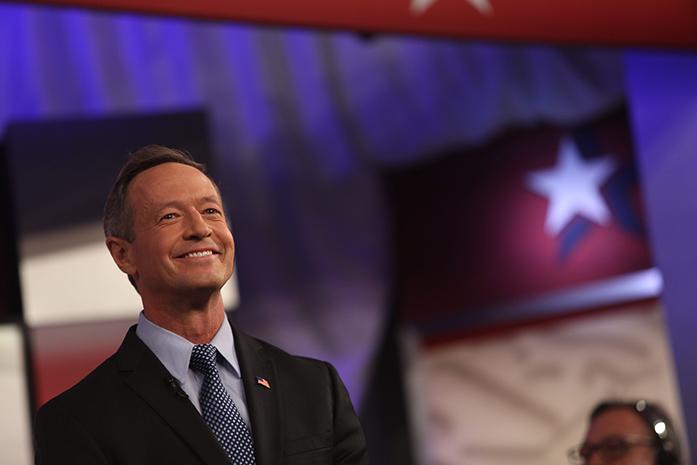Martin O’Malley sees ‘breakout’ performance at Democratic debate, Iowa political observers say.
By Quentin Misiag
quentin-misiag@uiowa.edu
DES MOINES — Martin O’Malley finally delivered a “long-necessary breakout” performance Nov. 14 that was complete with rolling punches at Democratic front-runner Hillary Clinton and a bold offensive strategy, Iowa political observers and Democratic organizers say.
“Strategically, he had the best performance of the night,” said John Deeth, a Democratic activist and blogger from Iowa City. “He’s out of the asterisk zone.”
Deeth keeps tabs on the movings and shakings of Iowa politics by penning johndeeth.com, a major source for Democratic activity in the state.
The second presidential primary debate at Drake University’s intimate Sheslow Auditorium provided O’Malley with fertile debating grounds, experts noted.
Deeth and several others interviewed by The Daily Iowan said Nov. 14 was the first time where O’Malley was able to show Iowans and the nation that he is a “plausible candidate for far-left undecided Democrats.”
“It seemed like every time it came back to O’Malley, he did what he needed to do to score points,” noted Tim Tracey, co-chairman of the Carroll County Democratic Party.
Black Hawk County Democratic Party Chairwoman Pat Sass had just one word to describe O’Malley’s appearance: fantastic.
Before all three candidates took the stage Nov. 14, O’Malley had struggled for months with low poll numbers both in Iowa and across the country.
Of the 615 usual Democratic voters surveyed in the latest Public Policy Polling survey released on Nov. 2, just 7 percent said they would like to see O’Malley as the Democratic candidate for president in 2016, compared with 57 percent backing Clinton and 25 percent supporting Bernie Sanders.
The November PPP poll had a margin of error of plus or minus 3.9 percentage points. Eighty percent of participants responded by phone, with the remaining 20 percent responding on the Internet.
O’Malley had done almost 120 events over 43 days in Iowa as of Nov. 14, according to *DI* records. Poll numbers aside, he has also failed match Clinton and Sanders’ vast donor networks.
O’Malley surrogates and party activists saw Saturday as his best chance to tear down Clinton’s establishment wall and cast Sanders as an unelectable socialist.
When Clinton tried to relate her positions on Wall Street to the 9/11 terrorist attacks, O’Malley’s national spokeswoman, Lis Smith, dug deep.
Smith’s father worked in the World Trade Center complex “from the day it was built to the day it went down,” she wrote in a tweet Nov. 14. “Never invoke 9/11 to justify your Wall Street positions.”
“Anything can happen in a short amount of time,” said Sioux County Democratic Chairwoman Kim Van Es when asked if she believed O’Malley could whip together the critical 15 percent margins at individual precinct caucuses on Feb. 1, 2016. “I hope that he will.”
In Iowa’s Democratic caucus, participants split up in to “preference groups” based on the candidate they support. In order to be deemed “viable,” a candidate’s preference group has to have at least 15 percent of the attendees present at the caucus.
Backers of a “nonviable candidate (anyone that gets fewer than 15 percent) must move to a “viable” candidate. Then, party officials scan the results through several mathematical calculations to determine the number of “delegate equivalents” each candidate would take into the Democratic Party’s state convention.
O’Malley, 52, fashions himself as a lifelong Democrat and big-city mayor with 15 years of executive experience. He received one of the biggest applause lines of the night when he dubbed Republican presidential candidate Donald Trump an “immigrant-bashing carnival barker.”
When debate moderators shifted the discussion to Wall Street reform, O’Malley hit at Clinton hard.
If elected president, O’Malley said his White House economic circle would be inclusive. A longtime advocate of reinstating the 1933 Glass-Steagall Act, O’Malley said Clinton’s plan was “weak tea.”
Under the O’Malley White House, a modern version of Glass-Steagall would force large U.S. banking institutions to separate their investment and commercial banking operations.
The latest date on the debate stage was a “breakout” for O’Malley in Iowa, but he faces an “uphill battle” of support at the precinct level, said Chris Budzisz, a Loras College associate professor of politics and director of the Loras Poll.
Too, he may not be able take a campaign that has largely hinged on Iowa and New Hampshire to a national level, they say.
“He may get some notice after this, but I don’t know if it’s enough to keep his campaign going a long time after Iowa and New Hampshire,” said Christopher Larimer, an associate professor of political science at the University of Northern Iowa who studies political behavior and state political movements.
While observers claimed different viewpoints on O’Malley’s latest Iowa moment, preliminary data from Twitter showed that he has benefited from increased name recognition.
At his peak, 14 percent of Twitter activity regarding the debate was related to O’Malley.
“He finally has a seat at the table,” said Deeth, the Iowa activist and blogger. “It’s a small seat, but people are finally going to start taking him more seriously.”
Daily Iowan reporter Tom Ackerman contributed to this report.



